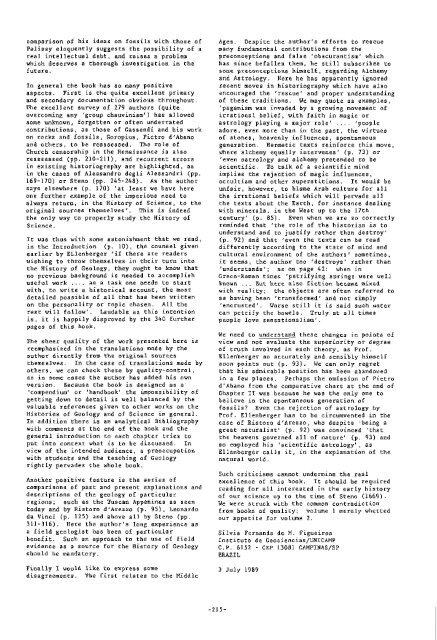Number 5 - Geological Curators Group
Number 5 - Geological Curators Group
Number 5 - Geological Curators Group
You also want an ePaper? Increase the reach of your titles
YUMPU automatically turns print PDFs into web optimized ePapers that Google loves.
comparison of his ideas on fossils with those ofPalissy eloquently suggests the passibility of areal intellectual debt, and raises a problemwhich deserves a thorough investigation in thefuture.In general the book has 80 many positiveaspects. First is the quite excellent primaryand secondary documentation obvious throughout.The excellent survey of 279 authors (quiteovercoming any 'group chauvinism') has allowedsome unknown, forgotten or often underratedcontributions, as those of Gassendi and his workon rocks and fossils, Goropius, Pietro d'Abanoand others, to be reassessed. The role ofChurch censorship in the Renaissance is alsoreassessed (pp. 210-211), and recurrent errorsin existing historiography are highlighted, asin the cases of Alessandro degli Alessandri (pp.169-170) or Steno (pp. 245-248). As the authorsays elsewhere (p. 170) 'at least we have hereone further example of the imperious need toalways return, in the History of Science, to theoriginal sources themselves'. This is indeedthe only way to properly study the History ofScience.1t was thus with some astonishment that we read,in the Introduction (p. IO), the counsel givenearlier by ELlenberger 'if there are readerswishing to throw themselves in their turn intothe History of Geology, they ought to know thatno previous background is needed to accomplishuseful work .... as a task one needs to startwith, to write a historical account, the mostdetailed possible of all that has been writtenon the personality or topic chosen. All therest will follow'. Laudable as this intentionis, it is happily disproved by the 340 furtherpages of this book.The sheer quality of the work presented here isreemphasized in the translations made by theauthor directly from the original sourcesthemselves. In the ease of translations made byothers, we can check these by quality-contral,as in some cases the author has added his ownversion. Because the book is designed as a'compendium' or 'handbook' the impossibility ofgetting down to detail is well balanced by thevaluable references given to other works on theHistories of Geology and of Science in general.In addition there is an analytical Bibliographywith comments at the end of the book and thegeneral introduction to each chapter tries toput into context what is to be discussed. Inview of the intended audience, a preoccupationwith students and the teaching of Geologyrightly pervades the whole book.Another positive feature is the series ofcomparisons of past and present explanations anddescriptions of the geology of particularregions; such as the Tuscan Appenines as seentoday and by Ristoro d'Arezzo (p. 951, Leonardoda Vinci (p. 125) and above all by Steno (pp.311-316). Here the author's long experience asa field geologist has been of particularbenefit. Such an approach to the use of fieldevidence as a source for the History of Geologyshould be mandatory.Finally I would like to express somedisagreements. The first relates to the MiddleAges. Despite the author's efforts to rescuemany fundamental contributions from thepreconceptions and false 'obscurantism' whichhas since befallen them, he still subscribes tosome preconceptions himself, regarding Alchemyand Astrology. Here he has apparently ignoredrecent moves in historiography which have alsoencouraged the 'rescue' and proper understandingof these traditions. We may quote as examples,'paganism was invaded by a growing movement ofirrational belief, with faith in magic orastrology playing a major role' .... 'peopleadore, even more than in the past, the virtuesof stones, heavenly influences, spontaneousgeneration. Hermetic texts reinforce this move,where alchemy equally intervenes' (p. 73) or'even astrology and alchemy pretended to bescientific. Fa talk of a scientific mindimplies the rejection of magic influences,occultism and other superstitions. It would beunfair, however, to blame Arab culture for allthe irrational beliefs which will pervade allthe texts about the Earth, for instance dealingwith minerals, in the West up to the 17thcentury' (p. 85). Even when we are so correctlyreminded that 'the role of the historian is tounderstand and to justify rather than destroy'(p. 92) and that 'even the texts can be readdifferently according to the state of mind andcultural environment of the authors' sometimes,it seems, the author too 'destroys' rather than'understands'; as on page 42: when inGreco-Roman times 'petrifying springs were wellknown ... But here also fiction became mixedwith reality; the objects are often referred toas having been 'transformed' and not simply'encrusted'. Worse still it is said such watercan petrify the bowels. Truly at all timespeople love sensationalism'.We need to understand these changes in points ofview and not evaluate the superiority or degreeof truth involved in each theory, as Prof.Ellenherger so accurately and sensibly himselfsoon points out (p. 93). We can only regretthat his admirable position has been abandonedin a few places. Perhaps the omission of Pietrod'Abano from the comparative chart at the end ofChapter I1 was because he was the only one tobelieve in the spontaneous generation offossils? Even the rejection of astrology byProf. Ellenberger has to be circumvented in thecase of Ristoro d'drezzo, who despite 'being agreat naturalist' (p. 92) was convinced 'thatthe heavens governed all of nature' (p. 93) andso employed his 'scientific astrology', asEllenberger calls it, in the explanation of thenatural world.Such criticisms cannot undermine the realexcellence of this book. It should be requiredreading for all interested in the early historyof our science up to the time of Steno (1669).We were struck with the common contradictionfrom books of quality; volume 1 merely whettedour appetite far volume 2.Silvia Fernanda de M. FigueiroaInstituto de Geociencias/UNICAMPC.P. 6152 - CEP 13081 CAMPINAS/SPBRAZIL3 July 1989
















